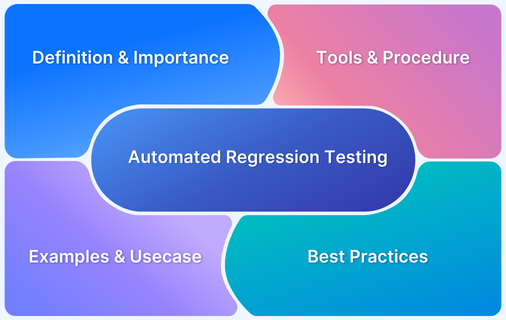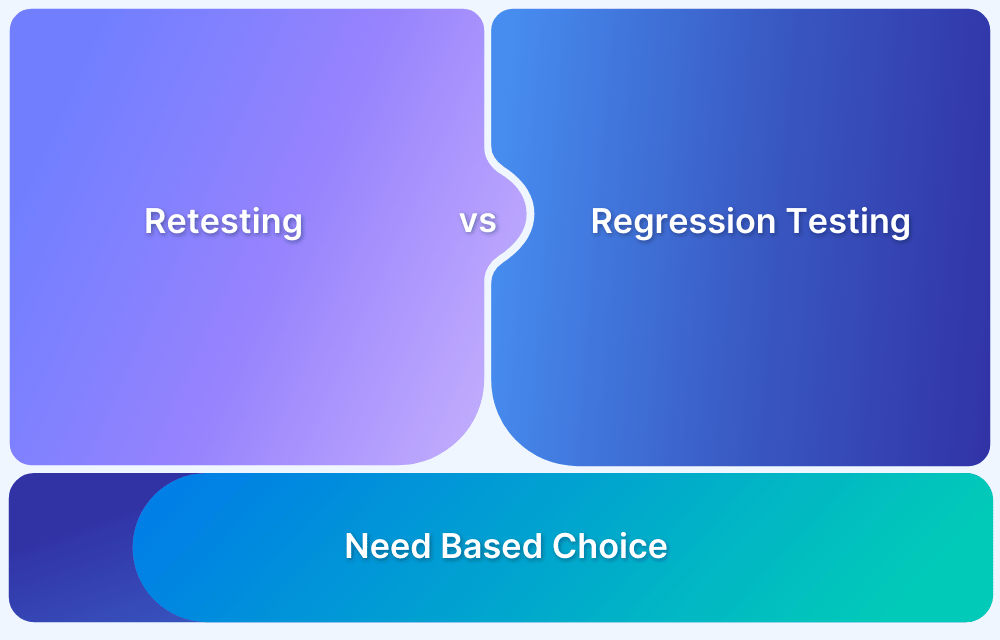In Agile environments, where changes happen rapidly, regression testing must evolve to match the pace.
Overview
What Is Regression Testing?
Regression testing involves re-running test cases to verify that previously developed features still perform as expected after recent code changes.
Importance of Regression Testing in Agile
It safeguards against unintended side effects from frequent code changes and ensures consistent performance across fast-paced development cycles.
How to Implement Regression Testing in Agile:
- Involve testers from the start of each sprint
- Automate repetitive and high-impact test cases
- Continuously update regression suites with every iteration
- Prioritize testing for areas impacted by recent changes
- Run tests frequently using real devices and parallel execution for faster feedback
This article covers how Agile teams can efficiently integrate and scale regression testing across sprints for higher release confidence.
What Is Regression Testing?
Regression testing is re-running functional and non-functional tests to ensure that previously developed and tested code performs correctly after changes.
These changes may include bug fixes, feature enhancements, configuration updates, or integrations.
The goal is to catch any unintended side effects or breakages in existing functionality caused by recent modifications.
Importance of Regression Testing in Agile
In Agile development, where code changes are frequent and iterative, regression testing is critical in maintaining product stability and quality.
It ensures that new updates do not disrupt existing features, enabling teams to release confidently and continuously.
Also Read: What is Continuous Delivery in Devops?
Key reasons regression testing is essential in Agile:
- Supports Continuous Delivery: Validates every iteration, allowing faster and safer releases.
- Reduces Risk of Bugs in Production: Identifies regressions early, minimizing costly rollbacks or hotfixes.
- Maintains User Experience: Ensures consistent functionality, preserving trust and usability across updates.
- Improves Test Coverage Over Time: As tests accumulate, they act as a safety net against future regressions.
- Enables Confident Refactoring: Developers can optimize or restructure code without fear of breaking existing features.
Learn More: Automated Regression Testing: A Detailed Guide
What is the issue with Regression Testing and Agile?
As the name suggests, Agile development is about speed. Sprint cycles are short (two weeks at most, usually less), and developers push out specific features in each. Test cycles must also be timed in similar bursts to keep pace with development.
However, in the real world, every time a new feature is introduced, it needs to be tested along with all the already existing features. With every new build, there is a possibility that recent code will clash with previously written code, thus disrupting existing features or functions. User experience needs to be improved by new functions, not degraded.
Regression testing helps achieve this by checking if new code contradicts or scrambles older features. It ensures that new code enhances, or at least leaves old code unaffected with every build.
Obviously, repeating tests of increasingly expanding codebases is time-consuming, not to mention tedious and prone to error if done manually. Additionally, regression test cases should be kept up to date by removing test cases related to previously tested features and adding those pertaining to the newly added ones.
To avoid this, regression testing needs to be strategized and set up in alignment with Agile principles and processes to avoid this.
How Regression Testing Fits Into the Agile Development Lifecycle
In Agile, development happens in rapid, iterative cycles (sprints). Regression testing fits seamlessly by validating that new code changes do not break existing functionality after each sprint or integration.
It supports the test early, test often philosophy, helping maintain software stability throughout the lifecycle.
When to Perform Regression Testing in Agile
Regression testing should be integrated into key stages of the Agile cycle to catch issues early and maintain stability.
- End of Each Sprint: Validate that new features haven’t broken existing functionality.
- After Bug Fixes: Confirm the fix and ensure related areas remain unaffected.
- Before Release or Deployment: Run tests to ensure product readiness and avoid regressions in production.
- After Code Integration or Merges: Check for conflicts or side effects introduced by merged code.
- After Major UI or Backend Changes: Ensure core workflows and user experience remain intact.
Building an Agile Regression Testing Strategy
A strong regression testing strategy in Agile combines automation, prioritization, and continuous execution. Here’s how to build it:
- Prioritize Test Cases: Focus on high-impact and frequently used features.
- Automate Repetitive Tests: Use automation tools to cover stable and recurring test cases.
- Update Test Suites Frequently: Modify tests as features evolve to ensure relevance.
- Integrate Into CI/CD Pipelines: Trigger tests automatically during code integration for faster feedback.
How to Implement Regression Testing in Agile
Step-by-step implementation of regression testing in Agile involves:
- Identify Critical Functionality: Choose core workflows and high-risk areas for testing.
- Select Tests for Automation: Focus on stable, repeatable scenarios ideal for automation.
- Use CI/CD Tools: Integrate with tools like Jenkins, GitHub Actions, or CircleCI for automated test runs.
- Run Tests Regularly: Trigger regression tests after every code change or sprint to maintain stability.
- Monitor and Refactor: Continuously refine test cases to align with product changes and avoid redundancy.
Also Read: Top 20 Regression Testing Tools
Examples of Regression Testing in Agile
Here are some examples of regression testing in Agile:
Example 1: A login feature is enhanced to support multi-factor authentication. Regression tests are run to ensure traditional login, password reset, and session management still work.
Example 2: A new payment gateway is added. Regression tests validate the shopping cart, order summary, and checkout flow to confirm existing functionality hasn’t been disrupted.
Example 3: A UI redesign is rolled out. Regression tests check that navigation, form inputs, and buttons across various screens remain functional and visually intact.
Why Use BrowserStack for Regression Testing in Agile
BrowserStack Automate provides a reliable, real device cloud for running automated regression tests across real devices and browsers. It enables Agile teams to test efficiently and release faster.
Key Benefits:
- Test on 3500+ real devices and browsers for accurate, consistent results
- Eliminate false positives caused by emulators or simulators
- Run tests in parallel to reduce execution time and speed up feedback
- Validate application behavior under real user conditions
- Integrate seamlessly with CI/CD tools like Jenkins, GitHub Actions, and CircleCI
BrowserStack helps Agile teams maintain fast, reliable regression test cycles without the overhead of managing in-house device labs.
Best Practices for Regression Testing in Agile Environment
Regression testing must evolve with every sprint cycle for an Agile workflow to be effective. Below are key practices for maintaining speed and accuracy while minimizing risk.
- Start Testing Early: Involve testers from the first sprint to design regression tests alongside feature development.
- Automate Strategically: Automate frequently executed and stable test cases to reduce manual effort. Introduce automation once core features are in place, and maintain a balance with manual verification to prevent false positives.
- Update the Test Suite Regularly: Review and refine your regression suite after every sprint. Remove outdated cases and add new ones based on changes introduced.
- Prioritize Critical Functional Areas: Focus tests on high-risk, user-facing features or areas frequently impacted by code changes. Leverage developer insights to identify vulnerable points.
- Avoid 100% Automation: Aim for 70–90% automation. Leave room for exploratory and UI-based tests that need human validation.
- Leverage Real Device Testing: To capture environment-specific bugs, validate regression scenarios across real devices. BrowserStack enables quick regression runs across actual Android and iOS devices in live or automated test environments.
Challenges of Regression Testing in Agile
Agile regression testing presents unique challenges that can affect speed and quality if not addressed early.
- High Frequency of Changes: Frequent feedback loops introduce changes that can invalidate existing regression scripts mid-sprint.
- Rapidly Expanding Test Suites: Each sprint adds new features, causing the regression suite to grow quickly and require constant re-evaluation.
- Ongoing Test Case Maintenance: After the sprint, outdated tests must be removed and relevant ones added. This becomes time-consuming without automation.
- Cross-Team Communication Gaps: Testers need continuous alignment with developers, analysts, and stakeholders. Small teams may find this hard to manage.
- Need for Skilled Test Automation: Effective automation demands familiarity with frameworks like Selenium or Appium, and the ability to run tests across diverse environments. Assembling such talent can be resource-intensive for newer teams.
Also Read: Regression Testing with Selenium: Tutorial
Measuring the Effectiveness of Regression Testing in Agile
Evaluating regression testing in Agile requires clear metrics to ensure it supports rapid development without compromising quality. Key indicators include:
- Test Coverage: Assess the percentage of critical functionalities covered by regression tests. Higher coverage reduces the risk of undetected bugs.
- Defect Detection Rate: Track the number of defects caught during regression testing versus post-release bugs. Effective regression testing should minimize production issues.
- Test Execution Time: Monitor how long regression suites take to run. Faster execution enables quicker feedback and supports Agile’s rapid iterations.
- Test Flakiness: Identify tests that produce inconsistent results. Reducing flaky tests improves reliability and developer trust.
- Automation Ratio: Measure the proportion of automated tests versus manual ones. Increasing automation accelerates regression cycles while maintaining accuracy.
Using BrowserStack’s cloud infrastructure allows teams to run regression tests on thousands of real devices and browsers simultaneously, providing fast, reliable results that improve these metrics and enhance overall testing effectiveness.
Conclusion
Regression testing is critical in Agile development, ensuring new changes do not break existing functionality. When executed with strategic automation, real-device testing, and continuous updates, it accelerates release cycles while maintaining software quality.
Leveraging tools like BrowserStack enables teams to run reliable regression tests across diverse environments, gaining confidence in every sprint delivery.
This comprehensive approach to regression testing supports Agile’s promise of fast, high-quality software development.







